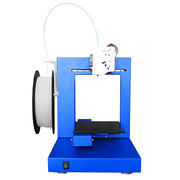Equipment/3D Printer/Up
Using the UP! 3D Printer
YOU CAN ONLY USE THE UP 3D PRINTER IF YOU HAVE BEEN TRAINED ON IT
Being trained on the Makerbot is a different induction from being trained on the Up!
The UP! 3D printer suffered an electronics failure, and has had its control circuitry replaced with a RepRap Melzi controller board. Software required to control the Up! is installed on the 3D printer PC, alongside the Makerbot.
Owners/Trainers: Brian Starkey
Caveats
The Up! is intended for use by those who wish to take more control of the 3D printing process and are interested in experimentation. The software workflow is less-friendly than the Makerbot, but infinitely more flexible.
Instructions
DO NOT EVER LEAVE THE PRINTER UNATTENDED
Startup The Up! requires two power supplies - a 20V high power supply which drives the bulk of the print (motors, heaters) and a separate 5V supply which drives the #Filament Feeder.
Both supplies are plugged in to a switchable power strip plugged in to the wall behind the PC - it is marked "Up". Turning this strip on will power up the printer.
Note: Upon powering up, the Filament Feeder and extruder fan will come on immediately. Due to a blown FET the fan is permanently on, the feeder however should stop after a number of seconds.
Bed Levelling/Calibration
The Up! seems to be less sensitive to slight misalignments in the bed to the Makerbot. In part this is probably due to the high-adhesion ABS build plate.
If you do feel the need to level the build plate, then there are 3 bolts on the underside of the pinkish bed mounting block. The bed rides on 3 silicone grommets, and by adjusting the bolts you can compress the grommets to varying degrees to achieve a level build plate.
At present the bed levelling procedure is a fairly manual affair, requiring manual entry of G-code into the Pronterface command window. The suggested calibration procedure is given below.
- Load your G-code file into Pronterface.
- Take note of the part dimensions reported in the command window.
- In the G-codes below, the following substitutions should be used:
- <centre_x>, <centre_y>: The build centre coordinates as specified when Slicing
- <min_x>, <min_y>, <max_x>, <max_y>: The minimum x,y coords as shown by pronterface. e.g.: from <min_x> mm to <max_x> mm in X
- <centre_x>, <centre_y>: The build centre coordinates as specified when Slicing
G28 # Home all axes # Note: Use Z2 initially to make sure there is enough clearance on the extruder G0 X<centre_x> Y<centre_y> Z2 # If you are happy that there is 2 mm more space in the Z-axis, continue with the calibration with <z_min> = 0 # Otherwise try larger values of <z_min> (decimals are allowed) e.g. <z_min> = 0.2 # In this case you should re-slice your part, specifying <z_min> in the Z offset field on the Printer Settings tab # Repeat the following commands, adjusting the bolts to provide a < 1 mm gap between the extruder and the bed in all positions G0 X<centre_x> Y<centre_y> Z<min_z> G0 X<min_x> Y<min_y> Z<min_z> G0 X<max_x> Y<max_y> Z<min_z> G0 X<min_x> Y<max_y> Z<min_z> G0 X<max_x> Y<min_y> Z<min_z> G28 # Home all axes
If you had to use a <min_z> greater than 0, remember to re-slice your model with the correct Z Offset!
Note: The firmware end-stops will not allow Z-coordinates < 0 so don't try!
Slicing
Finishing
Power Down
Cost
Currently we charge 10 pence per gram for prints, this is to cover the cost of material plus a little for wear and tear and other consumables. You can weigh printed parts using the scales next to the blue honesty box. Please put your money into the blue labelled honesty box on the shelf above the printer.
